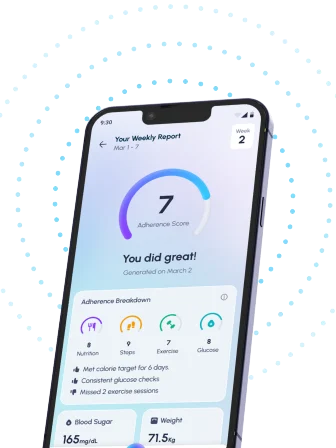Table of Contents
- Understanding Liver Disease in Diabetes
- Diabetes & Liver Problems: A Comprehensive Guide
- What are the Symptoms of Diabetic Liver Disease?
- Causes of Liver Damage Related to Diabetes
- Protecting Your Liver When You Have Diabetes
- Frequently Asked Questions
- References
Living with diabetes comes with its own set of challenges, and unfortunately, liver problems are a significant concern for many. Understanding diabetes-related liver problems: symptoms & causes is crucial for effective management and preventing serious complications. This often overlooked connection between diabetes and liver health can significantly impact your overall well-being. We’ll explore the common symptoms, delve into the underlying causes, and equip you with the knowledge to proactively protect your liver. Let’s unravel this complex relationship and empower you to take control of your health.
Understanding Liver Disease in Diabetes
Diabetes significantly increases the risk of developing various complications, and liver disease is a concerning one, particularly prevalent in Indian and tropical countries. The high prevalence of diabetes and related metabolic disorders in these regions makes understanding this connection crucial. While not as widely discussed as diabetic nephropathy (where nearly 30% of diabetics develop diabetic nephropathy), liver problems can silently progress, causing significant damage.
Causes of Liver Disease in Diabetes
Several factors contribute to the increased risk of liver disease in individuals with diabetes. High blood sugar levels damage the liver cells over time, leading to inflammation and fatty liver disease (NAFLD). This is often exacerbated by lifestyle factors common in many tropical and Indian regions, including unhealthy diets high in saturated fats and refined carbohydrates, and lack of physical activity. Insulin resistance, a hallmark of diabetes, further contributes to fat accumulation in the liver, worsening the condition. Additionally, certain viral infections, more prevalent in some tropical regions, can put diabetic individuals at higher risk of severe liver complications.
Symptoms of Liver Disease in Diabetes
Early stages of diabetic liver disease often present with minimal symptoms, making early detection challenging. However, as the condition progresses, symptoms like fatigue, abdominal pain, jaundice (yellowing of the skin and eyes), and dark urine can emerge. It’s crucial to remember that these symptoms can also be indicative of other health problems, so a proper diagnosis is essential. Regular check-ups are vital for managing diabetes and detecting potential liver complications early.
Taking Action
Given the high prevalence of diabetes and the associated risks of liver disease in Indian and tropical countries, proactive steps are vital. Maintain a healthy lifestyle with regular exercise and a balanced diet rich in fruits and vegetables. Regular check-ups including liver function tests are crucial, particularly for those with diabetes. Early diagnosis and management can significantly improve outcomes and reduce the risk of long-term liver damage. Consult your doctor for personalized advice and screening. For more information on the connection between diabetes and fatty liver disease, please see our article on The Link Between Diabetes and Fatty Liver. Understanding Fatty Liver is also crucial for prevention and management.
Diabetes & Liver Problems: A Comprehensive Guide
Diabetes significantly impacts liver health, especially in populations like those in India and other tropical countries. A staggering 61% of individuals with diabetes are aged between 20-64 years, a crucial working-age demographic, while 39% are 65+, according to the International Diabetes Federation. This highlights the widespread and age-diverse nature of the problem, demanding increased awareness and proactive healthcare measures.
Understanding the Connection
High blood sugar, a hallmark of diabetes, can lead to several liver complications. Fatty liver disease (NAFLD), a common condition among people with diabetes, occurs when excess fat accumulates in the liver. This can progress to non-alcoholic steatohepatitis (NASH), causing inflammation and potential liver damage. In advanced stages, NASH can result in cirrhosis and liver failure. Other liver problems linked to diabetes include increased risk of liver infections and impaired liver function. These complications disproportionately affect individuals in tropical climates due to various factors, including dietary habits and prevalence of underlying health conditions.
Recognizing Symptoms
Symptoms of diabetes-related liver problems often mimic other conditions, making early detection crucial. These can include fatigue, abdominal discomfort, jaundice (yellowing of the skin and eyes), and unexplained weight loss. It’s essential to consult a doctor if you experience such symptoms, especially if you have diabetes. Regular liver function tests are vital for early diagnosis and management in individuals with diabetes.
Taking Action
For those in India and tropical regions, managing diabetes effectively becomes even more critical to preventing liver complications. Adopting a healthy, balanced diet, rich in fruits, vegetables, and lean protein, and maintaining a healthy weight are crucial. Regular exercise and diligent blood sugar monitoring are also essential. Consulting with a healthcare professional for tailored advice and regular check-ups is strongly recommended, particularly considering the high prevalence of diabetes in these regions. Early intervention is key to mitigating the long-term consequences of diabetes-related liver problems. This is especially important as you age, so it’s vital to understand the challenges and solutions of managing diabetes as you age. For practical tips, see our guide on 10 Proven Tips to Effectively Manage Diabetes.
What are the Symptoms of Diabetic Liver Disease?
Diabetic liver disease, a significant concern for many, often presents subtly, making early detection crucial. While not directly related to foot ulcers (although nearly 15% of diabetics experience them in their lifetime, highlighting the broader impact of the disease), liver complications can worsen diabetes management and overall health. Recognizing symptoms early is vital for effective intervention, particularly in Indian and tropical countries where diabetes prevalence is high.
Early Signs & Symptoms:
Initial stages might show few overt symptoms. However, fatigue, unexplained weight loss, and abdominal discomfort (especially in the upper right quadrant) can be early warning signs. Some individuals may experience jaundice (yellowing of the skin and eyes), although this is often a later manifestation. Changes in urine color (darker urine) and stool color (lighter stools) can also indicate liver involvement. It’s important to note that these symptoms are not exclusive to diabetic liver disease and can be indicative of other conditions. Therefore, seeking medical attention is paramount. Understanding the early signs of diabetes itself is crucial for prevention. For more information, see our article on 10 Early Signs and Symptoms of Diabetes?
Advanced Symptoms:
As the disease progresses, more pronounced symptoms may develop, including ascites (fluid accumulation in the abdomen causing swelling), hepatic encephalopathy (confusion and disorientation due to liver dysfunction), and increased bleeding tendency. These advanced stages require immediate and intensive medical intervention. Given the prevalence of diabetes and the potential for severe complications in Indian and tropical climates, regular health check-ups are essential. Changes in taste and smell can sometimes be overlooked, but they can also be related to diabetes. To learn more, read our blog on Can Diabetes Cause Loss of Taste and Smell?
Seeking Help:
If you experience any of the above symptoms, or have concerns about your liver health, it is vital to consult a healthcare professional immediately. Early diagnosis and management can significantly improve outcomes and prevent serious complications. Don’t delay – your health is your most valuable asset.
Causes of Liver Damage Related to Diabetes
Diabetes significantly increases the risk of liver damage, a serious complication often overlooked. This is particularly relevant in Indian and tropical countries where diabetes prevalence is high and access to specialized healthcare may be limited. One contributing factor highlighted by research is smoking. Studies show smokers with diabetes face double the mortality rate due to cardiovascular issues, a complication often linked to liver dysfunction. This underscores the critical interplay between lifestyle choices, diabetes management, and liver health.
Non-Alcoholic Fatty Liver Disease (NAFLD)
The most common cause of diabetes-related liver damage is Non-Alcoholic Fatty Liver Disease (NAFLD). High blood sugar levels in diabetes lead to increased fat accumulation in the liver, causing inflammation and potentially scarring (cirrhosis). This is exacerbated by factors common in many Indian and tropical diets, such as high carbohydrate intake and less emphasis on fiber-rich foods. Early detection and management of NAFLD are vital to prevent progression to more severe liver conditions. For more information on preventing NAFLD, you might find our article on Nutrition for Liver Health: Preventing Fatty Liver Disease – Tap Health helpful.
Other Contributing Factors
Beyond NAFLD, other factors contribute to liver problems in individuals with diabetes. These include insulin resistance, which impairs the liver’s ability to process fats and sugars effectively. Additionally, chronic inflammation, a hallmark of diabetes, further damages liver cells. Furthermore, certain infections prevalent in tropical climates can worsen liver function in those with diabetes, making proactive healthcare crucial.
Protecting Your Liver
Maintaining healthy blood sugar levels through diet, exercise, and medication is paramount in preventing diabetes-related liver damage. Adopting a balanced diet rich in fruits, vegetables, and whole grains, along with regular physical activity, is crucial. Seeking regular check-ups with your physician for liver function tests is strongly recommended, especially if you have diabetes and live in a tropical or Indian region. Remember, proactive management can significantly reduce your risk. While this article focuses on liver damage, it’s also important to be aware of other potential complications of diabetes. For instance, you may want to read our article on Does Diabetes Cause Cancer?
Protecting Your Liver When You Have Diabetes
Diabetes significantly increases your risk of liver problems, a concern particularly relevant in India and other tropical countries. Up to 80% of Type 2 diabetes cases can be delayed or prevented through lifestyle changes, highlighting the crucial role of proactive management. This emphasizes the importance of protecting your liver, a vital organ often overlooked amidst diabetes care.
Understanding the Link Between Diabetes and Liver Disease
High blood sugar levels, a hallmark of diabetes, damage the liver over time. This can lead to non-alcoholic fatty liver disease (NAFLD), a condition characterized by fat accumulation in the liver. In advanced stages, NAFLD can progress to non-alcoholic steatohepatitis (NASH), causing inflammation and liver cell damage. These conditions are more prevalent in individuals with diabetes, especially in populations with higher rates of obesity and metabolic syndrome, common in many parts of India and other tropical regions.
Protecting Your Liver: Practical Steps
Managing your blood sugar effectively is paramount. This includes following a balanced diet, rich in fruits, vegetables, and whole grains, common in many Indian cuisines, while limiting processed foods and sugary drinks. Regular physical activity, even moderate exercise like brisk walking, is crucial. Maintaining a healthy weight is another key aspect. Regular check-ups with your doctor, including liver function tests, are essential for early detection and intervention. Remember that managing your cholesterol is also vital, as seen in our blog on How to Manage Cholesterol Levels with Diabetes?.
Seeking Support in India and Tropical Regions
In India and other tropical countries, access to affordable healthcare and education regarding diabetes and liver health varies. Seeking advice from your doctor or a registered dietitian is crucial. Many community health programs offer support and resources for managing diabetes and its complications. Remember, proactive steps to protect your liver can significantly improve your overall health and well-being. Protecting your heart is equally important, and you can learn more about that in our article, Protect Your Heart from Diabetes: 5 Essential Steps.
Frequently Asked Questions on Diabetes Liver Problems
Q1. What is the connection between diabetes and liver disease?
Diabetes significantly increases your risk of liver disease because high blood sugar damages liver cells and can lead to fatty liver disease (NAFLD).
Q2. What are the main risk factors for developing diabetes-related liver problems?
Besides diabetes itself, unhealthy diet, lack of physical activity, insulin resistance, and viral infections all increase your risk. These factors are especially prevalent in India and other tropical countries.
Q3. What are the symptoms of diabetes-related liver disease?
Early stages often have few noticeable symptoms. As the disease progresses, you might experience fatigue, abdominal pain, jaundice (yellowing of the skin and eyes), and dark urine.
Q4. How can I prevent or manage liver problems if I have diabetes?
Maintaining a healthy lifestyle is crucial. This includes eating a balanced diet, getting regular exercise, and consistently attending medical check-ups for monitoring and early detection.
Q5. How important are regular check-ups for detecting diabetes-related liver disease?
Regular check-ups and liver function tests are vital for early diagnosis. Early detection allows for timely intervention and helps mitigate long-term liver damage.
References
- A Practical Guide to Integrated Type 2 Diabetes Care: https://www.hse.ie/eng/services/list/2/primarycare/east-coast-diabetes-service/management-of-type-2-diabetes/diabetes-and-pregnancy/icgp-guide-to-integrated-type-2.pdf
- What is Diabetes: https://www.medschool.lsuhsc.edu/genetics/docs/DIABETES.pdf




